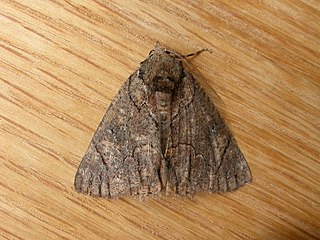Related Research Articles

Halone is a genus of moths in the subfamily Arctiinae from southern Asia and Australia. The genus was erected by Francis Walker in 1854.

Cephonodes hylas, the coffee bee hawkmoth, pellucid hawk moth or coffee clearwing, is a moth of the family Sphingidae. The species was first described by Carl Linnaeus in 1771. A widely distributed moth, it is found in the Near East, Middle East, Africa, India, Sri Lanka, Japan, Southeast Asia and Australia.

Halone sejuncta, the variable halone, is a moth of the subfamily Arctiinae first described by Rudolf Felder and Alois Friedrich Rogenhofer in 1875. It is found in Australia in Queensland, New South Wales, the Australian Capital Territory, Victoria, Tasmania and South Australia.
Stenarcha is a monotypic moth genus in the subfamily Arctiinae erected by George Hampson in 1900. Its single species, Stenarcha stenopa, was first described by Edward Meyrick in 1886. It is found in the southern part of the Australian state of Western Australia.

Heliomystis is a monotypic moth genus in the family Geometridae. Its only species, Heliomystis electrica, the electric moth, is found in the southern half of Australia. Both the genus and species were first described by Edward Meyrick in 1888.

Zermizinga is a monotypic moth genus in the family Geometridae erected by Francis Walker in 1863. Its only species, Zermizinga sinuata, the lucerne looper or spider moth, was described by Warren in 1897. It is found in the Australian states of New South Wales, Victoria and Tasmania.

Condica dolorosa is a moth of the family Noctuidae. It is found in the Indo-Australian tropics, including Borneo, Hawaii, Hong Kong, India, Sri Lanka, Taiwan and Queensland in Australia.

Halone pteridaula, the brown halone, is a species of moth of the subfamily Arctiinae first described by Turner in 1922. It is known from the Australian Capital Territory, New South Wales, Queensland, Tasmania and Victoria, all in Australia.

Serrodes campana is a species of moth of the family Erebidae first described by Achille Guenée in 1852. It is found from the Indo-Australian tropics to eastern Australia, Fiji, Samoa and New Caledonia. It is also present in Japan, Korea and Sri Lanka. The adult is a fruit piercer, but also feeds on flower nectar.

Anestia ombrophanes, the clouded footman, is a moth of the subfamily Arctiinae. The species was first described by Edward Meyrick in 1886. It is known from the Australian Capital Territory, New South Wales, Queensland, Western Australia and Victoria.

Epicoma contristis, the yellow-spotted epicoma, is a moth of the family Thaumetopoeidae first described by Jacob Hübner in 1823. It is known from Australia, including Tasmania, New South Wales and Victoria.

Diota rostrata is a species of moth of the subfamily Arctiinae first described by Wallengren in 1860. It is found in South Africa, Swaziland, Zimbabwe, Kenya and Ethiopia.

Manulea replana, the lichen-eating caterpillar or lichen moth, is a species of moth of the subfamily Arctiinae. It is found in Australia.
Asuroides sagenaria, the crossed footman, is a moth of the family Erebidae. It was described by Wallengren in 1860. It is found in the Democratic Republic of Congo, Mozambique, South Africa, Tanzania, Uganda, Zambia and Zimbabwe.
Halone ophiodes, the cryptic halone, is a moth of the subfamily Arctiinae. It was described by Edward Meyrick in 1886. It is found in Australia.
Heterallactis euchrysa is a moth of the family Erebidae. It was described by Edward Meyrick in 1886. It is found in the Australian states of Queensland and New South Wales.
Micralarctia punctulatum is a moth of the family Erebidae. It was described by Hans Daniel Johan Wallengren in 1860. It is found in Angola, Botswana, Cameroon, the Democratic Republic of the Congo, Eritrea, Ethiopia, Ghana, Kenya, Malawi, Mozambique, Namibia, Niger, Nigeria, Senegal, South Africa, Tanzania, Gambia, Uganda, Zambia and Zimbabwe.
Termessa gratiosa is a moth in the subfamily Arctiinae. It was described by Francis Walker in 1865. It is found in Australia, where it has been recorded from the Australian Capital Territory, New South Wales, Queensland and Victoria.

Erygia apicalis is a moth of the family Erebidae first described by Achille Guenée in 1852. It is found from the Indo-Australian tropics of India, Sri Lanka to Japan, Australia and the Solomon Islands. The habitat consists of lowland areas, including dry heath forests and softwood plantations.
Marmaroplegma paragarda, the speared monkey, is a moth in the family Eupterotidae. It was described by Wallengren in 1860. It is found in South Africa and Zimbabwe.
References
- ↑ Savela, Markku (7 December 2015). "Halone sinuata (Wallengren, 1860)". Lepidoptera and Some Other Life Forms. Retrieved 18 October 2019.
- ↑ Herbison-Evans, Don & Crossley, Stella (19 November 2011). "Halone sinuata (Wallengren, 1860) Rock Lichen Moth". Australian Caterpillars and their Butterflies and Moths. Retrieved 18 October 2019.
- Pitkin, Brian & Jenkins, Paul. "Search results Family: Arctiidae". Butterflies and Moths of the World. Natural History Museum, London.
| This Lithosiini-related article is a stub. You can help Wikipedia by expanding it. |